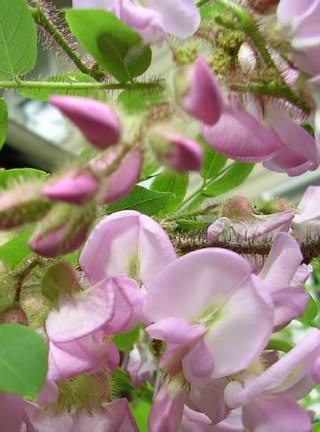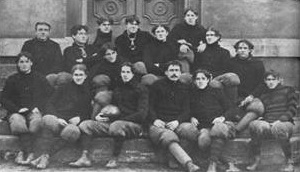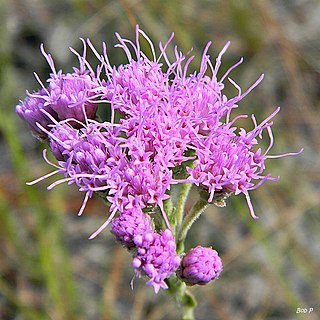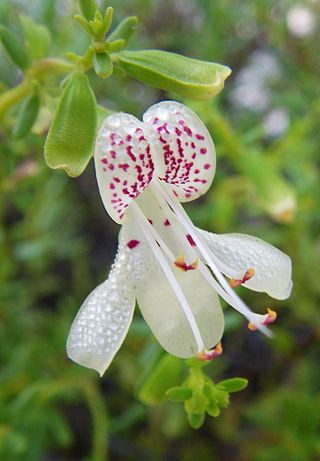
The Southeastern United States, also referred to as the American Southeast, the Southeast, or the South, is a geographical region of the United States located in the eastern portion of the Southern United States and the southern portion of the Eastern United States. The region includes a core of states that reaches north to Maryland and West Virginia, bordering the Ohio River and Mason–Dixon line, and stretches west to Arkansas and Louisiana.

Robinia hispida, known as the bristly locust, rose-acacia, or moss locust, is a shrub in the subfamily Faboideae of the pea family Fabaceae. It is native to the southeastern United States, and it is present in other areas, including other regions of North America, as an introduced species. It is grown as an ornamental and can escape cultivation and grow in the wild.

Tiarella, the foamflowers, is a genus of flowering plants in the family Saxifragaceae. The generic name Tiarella means "little turban", which suggests the shape of the seed capsules. Worldwide there are seven species, one each in eastern Asia and western North America, plus five species in eastern North America. As of October 2022, the taxonomy of Tiarella in eastern North America is in flux.

Baptisia is a genus in the legume family, Fabaceae. They are flowering herbaceous perennial plants with pea-like flowers, followed by pods, which are sometimes inflated. They are native to woodland and grassland in eastern and southern North America. The species most commonly found in cultivation is B. australis.

Chrysogonum virginianum, the golden-knee, green and gold, or goldenstar, is a North American species of plants in the family Asteraceae. It is native to the eastern United States from New York State and Rhode Island south to Louisiana and the Florida Panhandle.

Sarracenia minor, also known as the hooded pitcherplant, is a perennial, terrestrial, rhizomatous, herbaceous, carnivorous plant in the genus Sarracenia. Like all the Sarracenia, it is native to North America.

The 1895 Georgia Bulldogs football team represented the University of Georgia during the 1895 Southern Intercollegiate Athletic Association football season. The Bulldogs competed as a member of the Southern Intercollegiate Athletic Association (SIAA) and completed the season with a 3–4 record, Georgia's first losing season. Georgia lost twice to North Carolina, and played Alabama for the first time.

Eriogonum tomentosum, commonly referred to as dogtongue buckwheat or dogtongue wild buckwheat, is a species in the Polygonaceae family.

Carphephorus is a genus of North American plants in the family Asteraceae. They are native to the southeastern United States from Louisiana to Virginia. Plants of this genus are known commonly as chaffheads.

Dicerandra is a genus of flowering plants in the mint family. Dicerandra comprises 11 species: six perennial and five annual species. The perennials have narrow ranges in Central Florida with small population sizes and only occur on ancient dune ridges along the Lake Wales Ridge or the Atlantic coastal ridge; the annual species occur more broadly on sandhill habitats to the north. The perennials’ habitat has been severely fragmented due to human development over the past century. As a result, all perennial species except one are listed as federally endangered. Annual species of the clade have large ranges when compared to perennial members, with distributions of annuals ranging for hundreds of miles from the Panhandle of Florida to southeastern Georgia, with the exception of Dicerandra radfordiana which is endemic to two sites along the Altamaha river. The genus is characterized by hornlike spurs on their anthers.

Asclepias lanceolata, the fewflower milkweed, is a species of milkweed that is native to the coastal plain of the United States from New Jersey to Florida and Southeast Texas. A. lanceolata is an upright, perennial plant that can grow between 3 and 5 feet tall, with red-orange flowers blooming in the summer months. It can also be referred to as Cedar Hill milkweed, as it was first described by Dr. Eli Ives in the neighborhood of Cedar Hill in New Haven, Connecticut.
Balduina (honeycombhead) is a genus of North American plants in the sunflower family described as a genus in 1818.

Iris hexagona, commonly known as the Dixie iris, is a species in the genus Iris, it is also in the subgenus Limniris and in the series hexagonae. It is a rhizomatous perennial with long bright green leaves, long thin stem and has small groups of flowers in shades of blue, from violet, to bluish purple, to lavender. It flowers in springtime and is native to the southeastern and south-central US states.
Brickellia cordifolia is a North American species of flowering plants in the family Asteraceae. It is native to southeastern United States in the states of Florida, Georgia, and Alabama. Common names are Flyr's nemesis or Flyr's brickellbush.

Carphephorus odoratissimus, common name vanillaleaf, is a species of North American plants in the family Asteraceae. This species is native to the southeastern United States, including the states of Georgia, North Carolina, South Carolina, Alabama, Mississippi, Louisiana, and Florida.

Prunus alabamensis, the Alabama cherry or Alabama black cherry, is an uncommon or rare species of tree in the rose family endemic to parts of the Southeastern United States. It occurs in the states of Alabama, Florida, Georgia, Mississippi, and South Carolina. It is closely related to and found wholly within the range of Prunus serotina, the black cherry, a much more common and widespread species of Prunus that is also native to the region. Alabama cherry is sometimes considered to be a variety of Prunus serotina, however most authors treat it as a distinct species.

Quercus sinuata is a species of oak comprising two distinct varieties, Quercus sinuata var. breviloba and Quercus sinuata var. sinuata, occurring in southeast North America.
Hypericum harperi, the sharplobe St. Johnswort or Harper's St. John's wort, is a perennial flowering plant in the family Hypericaceae. It is an aquatic herb native to southeast North America. H. harperi has a diploid chromosome number of 24.

Quercus sinuata var. sinuata, commonly called Durand oak, is a variety of Quercus sinuata, a species of oak tree that grows in parts of the southern United States and northeastern Mexico.

Baptisia perfoliata, the catbells, is a species of flowering plant in the family Fabaceae. It is native to the US states of Alabama, Florida, Georgia, and South Carolina. A perennial reaching 3 ft (1 m), its yellow flowers appear in July and August.
















